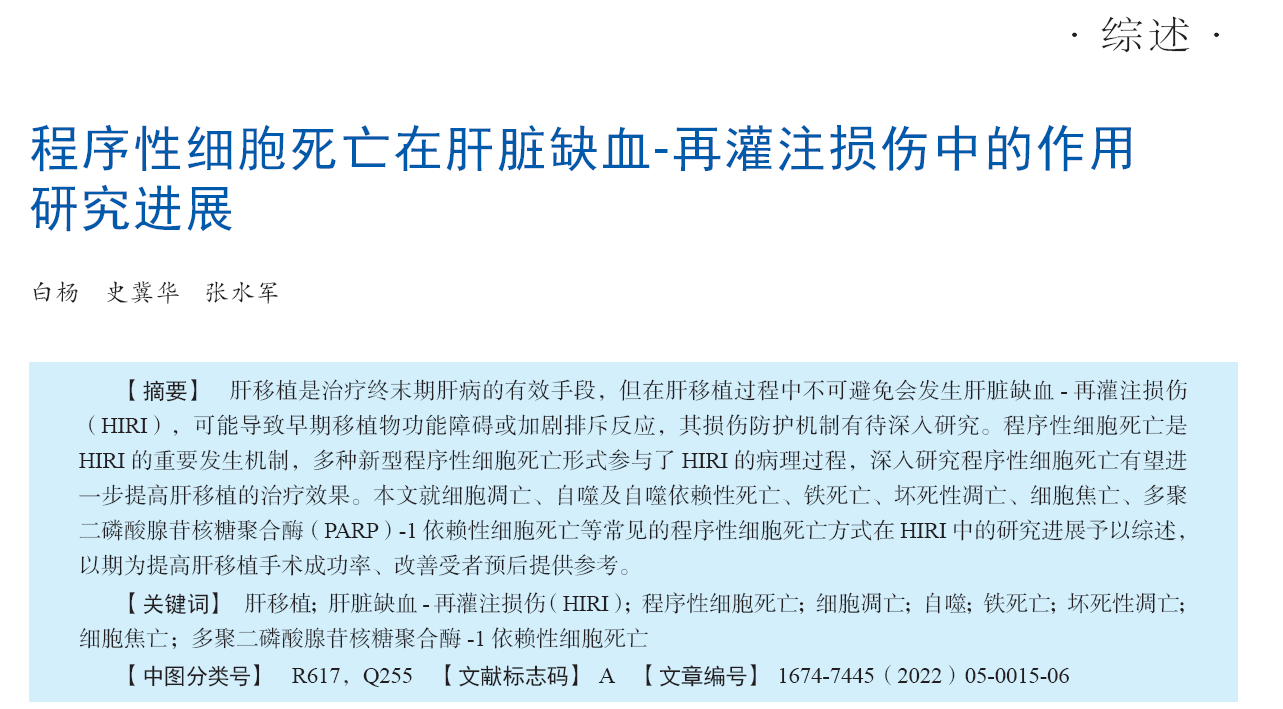| [1] |
DE STEFANO N, NAVARRO-TABLEROS V, ROGGIO D, et al. Human liver stem cell-derived extracellular vesicles reduce injury in a model of normothermic machine perfusion of rat livers previously exposed to a prolonged warm ischemia[J]. Transpl Int, 2021, 34(9): 1607-1617. DOI: 10.1111/tri.13980.
|
| [2] |
LOZANOVSKI VJ, DÖHLER B, WEISS KH, et al. The differential influence of cold ischemia time on outcome after liver transplantation for different indications-who is at risk? a collaborative transplant study report[J]. Front Immunol, 2020, 11: 892. DOI: 10.3389/fimmu.2020.00892.
|
| [3] |
干晓杰, 古鉴, 吕凌. 血红素加氧酶-1与自噬在肝脏缺血-再灌注损伤中的研究进展[J]. 器官移植, 2020, 11(1): 110-114. DOI: 10.3969/j.issn.1674-7445.2020.01.018.GAN XJ, GU J, LYU L. Research progress of HO-1 and autophagy in hepatic ischemia-reperfusion injury[J]. Organ Transplant, 2020, 11(1): 110-114. DOI: 10.3969/j.issn.1674-7445.2020.01.018.
|
| [4] |
RODRIGUES MG, CASTRO PMV, ALMEIDA TC, et al. Impact of cold ischemia time on the function of liver grafts preserved with custodial[J]. Transplant Proc, 2021, 53(2): 661-664. DOI: 10.1016/j.transproceed.2020.03.002.
|
| [5] |
KERR JF, WYLLIE AH, CURRIE AR. Apoptosis: a basic biological phenomenon with wide-ranging implications in tissue kinetics[J]. Br J Cancer, 1972, 26(4): 239-257. DOI: 10.1038/bjc.1972.33.
|
| [6] |
WESTABY D, JIMENEZ-VACAS JM, PADILHA A, et al. Targeting the intrinsic apoptosis pathway: a window of opportunity for prostate cancer[J]. Cancers (Basel), 2021, 14(1): 51. DOI: 10.3390/cancers14010051.
|
| [7] |
KASHYAP D, GARG VK, GOEL N. Intrinsic and extrinsic pathways of apoptosis: role in cancer development and prognosis[J]. Adv Protein Chem Struct Biol, 2021, 125: 73-120. DOI: 10.1016/bs.apcsb.2021.01.003.
|
| [8] |
LI K, VAN DELFT MF, DEWSON G. Too much death can kill you: inhibiting intrinsic apoptosis to treat disease[J]. EMBO J, 2021, 40(14): e107341. DOI: 10.15252/embj.2020107341.
|
| [9] |
FLUSBERG DA, SORGER PK. Surviving apoptosis: life-death signaling in single cells[J]. Trends Cell Biol, 2015, 25(8): 446-458. DOI: 10.1016/j.tcb.2015.03.003.
|
| [10] |
MAHDIZADEH SJ, THOMAS M, ERIKSSON LA. Reconstruction of the Fas-based death-inducing signaling complex (DISC) using a protein-protein docking Meta-approach[J]. J Chem Inf Model, 2021, 61(7): 3543-3558. DOI: 10.1021/acs.jcim.1c00301.
|
| [11] |
GUICCIARDI ME, MALHI H, MOTT JL, et al. Apoptosis and necrosis in the liver[J]. Compr Physiol, 2013, 3(2): 977-1010. DOI: 10.1002/cphy.c120020.
|
| [12] |
CURSIO R. Caspase inhibition in liver transplantation: from basic research to clinical studies[J]. HPB (Oxford), 2010, 12(1): 1-3. DOI: 10.1111/j.1477-2574.2009.00123.x.
|
| [13] |
JI H, ZHANG Y, SHEN XD, et al. Neuropeptide PACAP in mouse liver ischemia and reperfusion injury: immunomodulation by the cAMP-PKA pathway[J]. Hepatology, 2013, 57(3): 1225-1237. DOI: 10.1002/hep.25802.
|
| [14] |
GÓMEZ-GAVARA C, MOYA-HERRAIZ Á, HERVÁS D, et al. The potential role of efficacy and safety evaluation of N-acetylcysteine administration during liver procurement. the NAC-400 single center randomized controlled trial[J]. Transplantation, 2021, 105(10): 2245-2254. DOI: 10.1097/TP.0000000000003487.
|
| [15] |
DE DUVE C. The lysosome[J]. Sci Am, 1963, 208: 64-72. DOI: 10.1038/scientificamerican0563-64.
|
| [16] |
TAKESHIGE K, BABA M, TSUBOI S, et al. Autophagy in yeast demonstrated with proteinase-deficient mutants and conditions for its induction[J]. J Cell Biol, 1992, 119(2): 301-311. DOI: 10.1083/jcb.119.2.301.
|
| [17] |
KLIONSKY DJ, PETRONI G, AMARAVADI RK, et al. Autophagy in major human diseases[J]. EMBO J, 2021, 40(19): e108863. DOI: 10.15252/embj.2021108863.
|
| [18] |
LEVINE B, KROEMER G. Biological functions of autophagy genes: a disease perspective[J]. Cell, 2019, 176(1/2): 11-42. DOI: 10.1016/j.cell.2018.09.048.
|
| [19] |
LŐRINCZ P, JUHÁSZ G. Autophagosome-lysosome fusion[J]. J Mol Biol, 2020, 432(8): 2462-2482. DOI: 10.1016/j.jmb.2019.10.028.
|
| [20] |
LIN PW, CHU ML, LIU HS. Autophagy and metabolism[J]. Kaohsiung J Med Sci, 2021, 37(1): 12-19. DOI: 10.1002/kjm2.12299.
|
| [21] |
FANG H, LIU A, DAHMEN U, et al. Dual role of chloroquine in liver ischemia reperfusion injury: reduction of liver damage in early phase, but aggravation in late phase[J]. Cell Death Dis, 2013, 4(6): e694. DOI: 10.1038/cddis.2013.225.
|
| [22] |
LEI Z, DENG M, YI Z, et al. cGAS-mediated autophagy protects the liver from ischemia-reperfusion injury independently of STING[J]. Am J Physiol Gastrointest Liver Physiol, 2018, 314(6): G655-G667. DOI: 10.1152/ajpgi.00326.2017.
|
| [23] |
ZHENG J, CHEN L, LU T, et al. MSCs ameliorate hepatocellular apoptosis mediated by PINK1-dependent mitophagy in liver ischemia/reperfusion injury through AMPKα activation[J]. Cell Death Dis, 2020, 11(4): 256. DOI: 10.1038/s41419-020-2424-1.
|
| [24] |
WANG M, YUAN F, BAI H, et al. SHMT2 promotes liver regeneration through glycine-activated Akt/mTOR pathway[J]. Transplantation, 2019, 103(7): e188-e197. DOI: 10.1097/TP.0000000000002747.
|
| [25] |
CURSIO R, COLOSETTI P, GUGENHEIM J. Autophagy and liver ischemia-reperfusion injury[J]. Biomed Res Int, 2015: 417590. DOI: 10.1155/2015/417590.
|
| [26] |
XU H, BERENDSEN T, KIM K, et al. Excorporeal normothermic machine perfusion resuscitates pig DCD livers with extended warm ischemia[J]. J Surg Res, 2012, 173(2): e83-e88. DOI: 10.1016/j.jss.2011.09.057.
|
| [27] |
DIXON SJ, LEMBERG KM, LAMPRECHT MR, et al. Ferroptosis: an iron-dependent form of nonapoptotic cell death[J]. Cell, 2012, 149(5): 1060-1072. DOI: 10.1016/j.cell.2012.03.042.
|
| [28] |
ZHENG J, CONRAD M. The metabolic underpinnings of ferroptosis[J]. Cell Metab, 2020, 32(6): 920-937. DOI: 10.1016/j.cmet.2020.10.011.
|
| [29] |
YAMADA N, KARASAWA T, WAKIYA T, et al. Iron overload as a risk factor for hepatic ischemia-reperfusion injury in liver transplantation: potential role of ferroptosis[J]. Am J Transplant, 2020, 20(6): 1606-1618. DOI: 10.1111/ajt.15773.
|
| [30] |
DEGTEREV A, HUANG Z, BOYCE M, et al. Chemical inhibitor of nonapoptotic cell death with therapeutic potential for ischemic brain injury[J]. Nat Chem Biol, 2005, 1(2): 112-119. DOI: 10.1038/nchembio711.
|
| [31] |
XUE C, GU X, LI G, et al. Mitochondrial mechanisms of necroptosis in liver diseases[J]. Int J Mol Sci, 2020, 22(1): 66. DOI: 10.3390/ijms22010066.
|
| [32] |
ZHONG W, WANG X, RAO Z, et al. Aging aggravated liver ischemia and reperfusion injury by promoting hepatocyte necroptosis in an endoplasmic reticulum stress-dependent manner[J]. Ann Transl Med, 2020, 8(14): 869. DOI: 10.21037/atm-20-2822.
|
| [33] |
LIN J, KUMARI S, KIM C, et al. RIPK1 counteracts ZBP1-mediated necroptosis to inhibit inflammation[J]. Nature, 2016, 540(7631): 124-128. DOI: 10.1038/nature20558.
|
| [34] |
YANG F, SHANG L, WANG S, et al. TNFα-mediated necroptosis aggravates ischemia-reperfusion injury in the fatty liver by regulating the inflammatory response. [J] Oxid Med Cell Longev, 2019: 2301903. DOI: 10.1155/2019/2301903.
|
| [35] |
BRENNAN MA, COOKSON BT. Salmonella induces macrophage death by caspase-1-dependent necrosis[J]. Mol Microbiol, 2000, 38(1): 31-40. DOI: 10.1046/j.1365-2958.2000.02103.x.
|
| [36] |
KNORR J, WREE A, FELDSTEIN AE. Pyroptosis in steatohepatitis and liver diseases[J]. J Mol Biol, 2022, 434(4): 167271. DOI: 10.1016/j.jmb.2021.167271.
|
| [37] |
WANG Y, ZHANG H, CHEN Q, et al. TNF-α/HMGB1 inflammation signalling pathway regulates pyroptosis during liver failure and acute kidney injury[J]. Cell Prolif, 2020, 53(6): e12829. DOI: 10.1111/cpr.12829.
|
| [38] |
胡莎莎, 刘钰, 王朝阳, 等. HMGB1/Caspase-1/GSDMD信号轴介导肝细胞焦亡在肝脏缺血-再灌注损伤中的作用[J]. 器官移植, 2022, 13(1): 88-97. DOI: 10.3969/j.issn.1674-7445.2022.01.014.HU SS, LIU Y, WANG CY, et al. Effect of HMGB1/Caspase-1/GSDMD signaling axis-mediated hepatocyte pyroptosis on liver ischemia-reperfusion injury[J]. Organ Transplant, 2022, 13(1): 88-97. DOI: 10.3969/j.issn.1674-7445.2022.01.014.
|
| [39] |
ZHANG L, LIU H, JIA L, et al. Exosomes mediate hippocampal and cortical neuronal injury induced by hepatic ischemia-reperfusion injury through activating pyroptosis in rats[J]. Oxid Med Cell Longev, 2019: 3753485. DOI: 10.1155/2019/3753485.
|
| [40] |
FAGENSON AM, XU K, SAAOUD F, et al. Liver ischemia reperfusion injury, enhanced by trained immunity, is attenuated in Caspase 1/Caspase 11 double gene knockout mice[J]. Pathogens, 2020, 9(11): 879. DOI: 10.3390/pathogens9110879.
|
| [41] |
HUA S, MA M, FEI X, et al. Glycyrrhizin attenuates hepatic ischemia-reperfusion injury by suppressing HMGB1-dependent GSDMD-mediated kupffer cells pyroptosis[J]. Int Immunopharmacol, 2019, 68: 145-155. DOI: 10.1016/j.intimp.2019.01.002.
|
| [42] |
DAVID KK, ANDRABI SA, DAWSON TM, et al. Parthanatos, a messenger of death[J]. Front Biosci (Landmark Ed), 2009, 14(3): 1116-1128. DOI: 10.2741/3297.
|
| [43] |
KOEHLER RC, DAWSON VL, DAWSON TM. Targeting parthanatos in ischemic stroke[J]. Front Neurol, 2021, 12: 662034. DOI: 10.3389/fneur.2021.662034.
|
| [44] |
HAGA S, KANNO A, MORITA N, et al. Poly(ADP-ribose) polymerase (PARP) is critically involved in liver ischemia/reperfusion-injury[J]. J Surg Res, 2022, 270: 124-138. DOI: 10.1016/j.jss.2021.09.008.
|





 下载:
下载:





